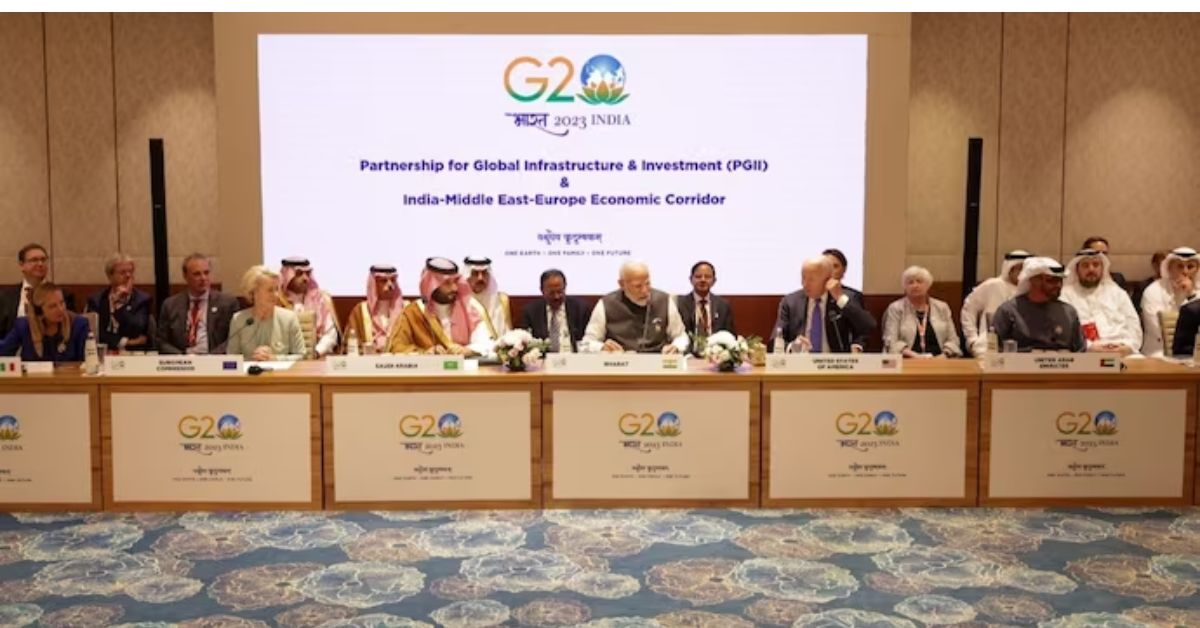The proposed India-Middle East-Europe Economic Corridor (IMEC) is a result of the peace initiatives taken by the then United States President Donald Trump in 2020. A memorandum of understanding (MoU) on IMEC was signed by India, US, Saudi Arabia, United Arab Emirates (UAE), European Union, Italy, France and Germany at the G20 summit held in New Delhi on September 9.
The IMEC comprises an Eastern Corridor connecting India to the Gulf region and a Northern Corridor connecting the Gulf region to Europe. It will include a railway and ship-rail transit network and road transport routes. Jitendra Singh, the Minister of State (Prime Minister’s Office) said the IMEC redeems post-Partition India’s quest for restoring deeper connectivity in the region. “It will address obstacles created by Pakistan’s denial of over-land access and China’s reported connectivity designs in the region,” he said.
A new dawn
As per the plan, the IMEC will begin at India’s west coast, preferably the Mumbai port. It will be connected to the UAE (preferably Dubai) through the sea route. Then a train link will connect the UAE to Saudi Arabia. The link will culminate at Port Haifa in Israel. From there it will be connected to Bahrain and Oman through sea route. Then it will be linked to Europe through a rail route.
Israel is all set to play an important role in the IMEC as its ties with the neighbouring countries are improving. In September 2020, UAE and Bahrain signed agreements in presence of Donald Trump to normalise relations with Israel. Earlier, Egypt and Jordan had established formal diplomatic relations with Israel.
The IMEC is similar to Russia’s ‘Trans-Siberian’ and China’s ‘Chongqing–Xinjiang–Europe’ rail corridor. However, both are geographically more in the northern part of EURASIA while IMEC is more towards the central and southern European region, which makes good sense. China’s loan shark approach with Global South countries in BRI projects, will give impetus to EU; They (EU) will prefer to see a more financially sound African Union (AU) in their backyard than an AU deeply sunk in Chinese debt. Interestingly the only European country in China’s BRI, Italy, too is likely to pull out of BRI.
Missing link
The absence of formal relations between Saudi Arabia and Israel is the only missing link in IMEC at present. US President Joe Biden is trying to bring Saudi Arabia and Israel on the same page as far as infrastructure development is concerned. It is likely that the work on IMEC will start even before they join hands. As IMEC will cut down shipping costs and transit time the gap between the Far East and Europe will be bridge. That will economically benefit all the participating countries.
Similarly, the IMEC will promote connectivity between Israel and its neighbours in transportation, infrastructure and information. Experts say the countries participating in IMEC will require to standardise the trucks to enable them to swiftly pass through all borders. Also, standardisation of drivers’ licenses and the authorised travel pass will be a need for smooth passage without delays.
The IMEC will upgrade upgrade global trade in West Asia and also improve Israel’s position as a hub for transporting goods from the far east to the west. The US looks at it as an opportunity to mark its presence in the region.
Challenges and solutions
Captain Naveen S. Singhal, a marine and shipping consultant based in Singapore, says since it is a multi-national project, resource allocation (project funding and monitoring) could be complex, particularly the railroad segment. “Once this is inked, then half the job is done,” he tells News9 Plus.
According to Singhal, most shippers in India find it difficult to get space on west-bound (US/Europe) container ships coming from the Far-East and China, since shipping companies (carriers) earn more freight for carrying a container from China to Europe than to pick one on their way from India to Europe. “Today Indian shippers often find their containers left behind in the yard, since ships coming from China and Far East are already full. Thus, IMEC is likely to bring relief to Indian shippers. Indian shipping companies (carriers) will be able to provide them assured space for their Europe and US bound cargo.”
At present, it costs about US$ 7000 to ship a 40-feet container from Mumbai to Rotterdam. “What will be interesting to see is, how much would a shipper in India be paying for sending the same container through IMEC?” says Singhal. There are other variables such as the cost a shipping company pays for Suez transit. A 20,000 TEU container vessel could pay around US$ 700K for a transit. Hence, if Egyptian authorities raise this cost, then existing freight of about US$ 7000 for a 40 feet container will also rise. “Volatility in oil prices, is another factor. With high oil prices, an Indian shipper may find it cheaper to route their cargo through IMEC which has limited sea passage and predominantly more on rails. Gulf countries could also ship LPG on rails to Europe,” Singhal says.







